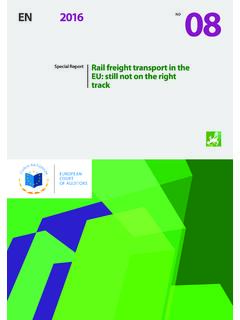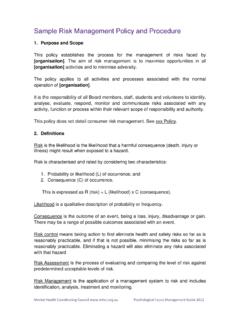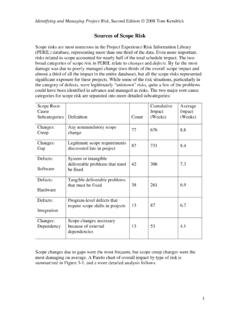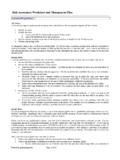Transcription of RISK ASSESSMENT IN PERFORMANCE AUDITS
1 ECA - Guideline on Risk ASSESSMENT October 2013 Page 1 EUROPEAN COURT OF AUDITORS audit METHODOLOGY AND SUPPORT UNIT RISK ASSESSMENT IN PERFORMANCE AUDITS TABLE OF CONTENTS FOREWORD Section 1: What is risk ASSESSMENT & when to perform it The purpose of risk ASSESSMENT Defining risk and risk ASSESSMENT Section 2: How to do it The auditor s approach to risk ASSESSMENT Step - Present the audited area in a diagram & list the expected key controls Step - Identify the risks Step - Analyse the risks to assess the risk level Step - Focus on the key risks to define the audit questions and scope Annexes I: Risk ASSESSMENT Process II: Sources of information III: Illustrative list of risks factors IV.
2 Examples of risks The PERFORMANCE audit Manual of the European Court of Auditors states that the preliminary study1 Guidance for carrying out risk ASSESSMENT in order to identify and analyse the risks to sound financial management, and allow a more structured approach to developing relevant audit questions. should analyse the relative significance of the risks to sound financial management, which will help to provide focus for both the potential audit questions and audit scope . The purpose of this guideline is to provide the auditor with: A template to document the result of the risk ASSESSMENT .
3 Section 1 gives a brief introduction to the method, its key concepts and tools, and discusses its main features and when to use it. Section 2 is a detailed guide for the auditor on how to perform risk ASSESSMENT in the planning of a PERFORMANCE audit . A case study, illustrating how a risk ASSESSMENT is carried out in practice, is annexed to this guideline. The case is adapted from the audit on Translation Expenditure of the Institutions2 List of related documents . Risk_my (template) Whom to contact If you feel that the information provided in this document could be improved, please do not hesitate to communicate your suggestions: 1 The purpose of the preliminary study is to enable the responsible Member to assess whether the audit is realistic, realisable and like to be useful.
4 The emphasis is on testing the availability of information and the feasibility of methods. 2 Special Report no 09/2006 on the translation expenditure incurred by the Parliament, the Commission and the Council. ECA - Guideline on Risk ASSESSMENT October 2013 Page 2 SECTION 1: WHAT IS RISK ASSESSMENT & WHEN TO PERFORM IT THE PURPOSE OF RISK ASSESSMENT Perform risk ASSESSMENT during preliminary study The PERFORMANCE audit Manual requires the auditor to perform risk ASSESSMENT during the preliminary study in order to: to focus the audit on high-risk areas. reveal areas of potential weakness in an organisation, identify risks and analyse those which are the most significant and critical to the achievement of good PERFORMANCE , examine how risks are managed by the organisation, focus the audit on areas of high risk and develop related potential audit questions.
5 Following the risk ASSESSMENT , the auditors will complete the Potential audit Question and Scope (PAQS) table, a tool which will help in choosing the high-level question(s) for the audit and in defining the audit scope. DEFINING RISK AND RISK ASSESSMENT What is risk? Risk can be defined in various ways, depending on the context. Generally, risk is considered as the possibility of loss or injury, a threat of something going wrong with the activities or organisation of the entity or persons concerned. In the EU context, the auditor deals mostly with organisations and programmes which have policy objectives.
6 Therefore, an objectives-based definition of risk is the most suitable. Risk is thus defined as an incident or the occurrence of a particular set of circumstances that, if they occur, could adversely affect the organisation, such as exposure to financial loss, loss of reputation or failure to deliver a policy or programme economically, efficiently or effectively. risks may vary in nature and concern any level of the organisation. risks to sound financial management, risks to achieving economy, efficiency and effectiveness, can be inherent in nature (inherent risk) and/or arise from weaknesses in internal control (control risk).
7 The inherent risk is the risk level before existing controls and/or risk response. Residual risk is the risk level still remaining after taking existing actions and controls into account. What is risk ASSESSMENT ? A general definition of risk ASSESSMENT is "the identification and analysis of relevant risks to the achievement of objectives, forming a basis for determining how the risks should be managed".3 In the context of a PERFORMANCE audit , risk ASSESSMENT can be defined as the identification and analysis of the key risks to the achievement of objectives concerning economy, efficiency and effectiveness, thus forming a basis for developing potential audit questions and determining the potential audit scope.
8 3 Enterprise Risk Management - Integrated Framework, The Committee of Sponsoring Organizations of the Treadway Commission (COSO), 2004. ECA - Guideline on Risk ASSESSMENT October 2013 Page 3 SECTION 2: HOW TO DO IT In four progressive steps. The risk ASSESSMENT process consists of four progressive steps, each step acting as a filter and leading to the next. This allows the auditor to start with the acquired knowledge of the audit area and to eventually focus on the key critical risks that lead to relevant potential audit questions and potential audit scope.
9 (see Annex I: The risk ASSESSMENT process: input, tools and output) Overview of the risk ASSESSMENT process List all the possible risks , group and describe them consistently. Identify the main risks to be assessed. Step 4: Focus on the key risks to define the audit questions and scope Achieve a thorough understanding of the audit area by: o Collecting data of high quality and relevance, o Considering risk factors and expected key controls Present the knowledge gained in a: o Programme Logic Model - &/or Flowchart o List of expected controls Step 3: Analyse the risks to assess the risk level Step 1: Present the audited area in a diagram & list the expected key controls Step 2: Identify the risks Excel worksheets in Analyse the main risks to assess the risk level.
10 Analyse the likelihood and potential impact of the risks and determine the risk level using the risk matrix. Examine the risk response in place to decide whether the risk level should be adjusted to obtain the level of residual risk. List of Identified risks Risk Analysis Table Potential audit Questions & Scope PAQS table Determine the key risks to the audit area and formulate potential audit questions to address them. Consider other criteria to outline the potential audit scope: o Relevance and interest o Feasibility o Alignment with Court s mandate Decide whether or not to include the audit Question in the scope Draw the PAQS table to present the results of the risk ASSESSMENT exercise.















